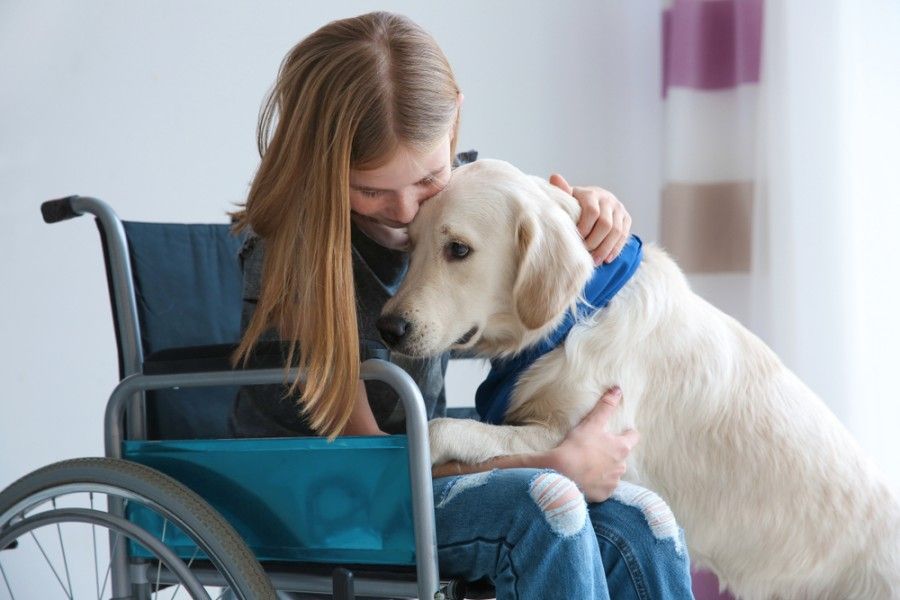Dog Therapy for Autism: Vet-Reviewed Facts & FAQ
Updated on

Click to Skip Ahead
In the Middle Ages in Belgium, individuals suffering from emotional trauma, grief, and other debilitating emotional conditions were often treated with the help of therapy animals. The animals provided physical and emotional relief for humans, and, in the centuries that followed, many other countries followed suit, using therapy animals to help humans recover.
Today, around 1 in 44 US children are autistic and around 1 in 5 are neurodiverse. Each autistic person has their own strengths, challenges, interests and personality but a commonality is greater difficulty with sensory regulation and social communication. As in Belgium during the Middle Ages, today, therapy dogs are working with autistic children and adults. Dog therapy for autism has been shown to be very helpful for autistic patients in many ways. Because of this, the number of practitioners using animal-assisted therapy with autistic patients is growing fast. To learn more about this therapy that takes advantage of the human-animal bond to help autistic people, read on.
How Does Dog Therapy for Autism Work?
Working with dogs to provide therapy for autistic people, otherwise known as animal-assisted therapy (AAT), takes advantage of most humans’ natural deep bond with animals, especially dogs, to help meet their therapy goals. Those goals typically involve opening communication and engagement with therapists.
At its core, animal-assisted therapy uses the human-animal bond concept. When humans interact and bond with dogs, they typically become calmer and more relaxed, improving their general mood. This reaction happens with all humans, regardless of any neurotype, conditions, illnesses or injuries they might have. Some of the other positive effects of AAT or dog therapy for autism include the following:
- Improved engagement of the patient with those around them
- Increased patient mobility via walking, playing, and interacting with the therapy dog
- A significant increase in social interactions between the patient and therapist
- A lessened sense of loneliness by the patient
- Reduced stress and anxiety on the part of the patient

Both Therapy Dogs and Their Handlers / Owners Are Given Training
Typically, the owner or handler of the therapy dog will bring the animal to the therapy session, working under the guidance of a certified therapy professional. The dogs are trained to behave well, stay calm, and interact with the patients in a controlled and relaxed fashion. In some cases, the owner or handler of the therapy dog also receives training. In most cases, both the therapy dog and its owner/handler must be certified before being allowed to engage in the therapy session.
When the dog is brought together with the patient, they are encouraged to interact with the animal by petting, stroking, and talking to them. In most cases, few instructions are necessary as the dogs and patients are naturally inclined to engage, and both will have a positive attitude toward the situation.
Therapy Sessions Are Similar But Unique
Since all patients are unique, each animal-assisted therapy session is also unique. In many cases, the patient will immediately react positively upon seeing the therapy dog, especially if they have already formed a bond with the animal. The patient’s stress level will decrease, and their attitude will change. Much of this is due to an increase in serotonin and dopamine levels by the patient, which is a normal reaction to what is considered a generally positive and joyous situation. Serotonin and dopamine are often referred to as the “happiness hormones.”
The therapy sessions will continue if the animal-assisted therapy works for the patient. In the best of circumstances, an autistic patient can receive dog therapy for weeks, months, and even years. In some cases, however, AAT is halted due to an adverse reaction by the patient, either fear, allergies, possessiveness towards the dog, or a combination of these things. Thankfully, these cases are far fewer than positive cases that result in a positive outcome.

What Are the Different Types of Dog Therapy for Autism?
The therapeutic use of the dog will depend on the type of therapist providing the therapy and the patient’s needs. For example, some patients are physically able to take their therapy dog for walks (with assistance from the owner or handler). Some patients can play with their therapy dog, using toys and props to engage. Others will simply pet their therapy dog or allow it to rest its head on its lap while they stroke its head and ears.
In all cases where dog autism therapy is used, the circumstances are similar. First, the dog is introduced to the patient but kept at arm’s length. If the patient has a positive reaction (which is typical), the therapy dog is allowed to approach. Contact is then made between the patient and the dog, and the handler and medical personnel assess the situation. If things go well, the patient is encouraged to engage further with the dog in whatever activities are suitable for both.
As mentioned, some autistic patients can take their therapy dog for walks while others can touch, pet, and physically engage from a seated, sedentary position. The therapy sessions last for specific periods and are usually performed at the same time and on the same day of the week to give the patient a sense of normalcy.
Where Is Dog Therapy for Autism Used?
Dog autism therapy is used in various locations and situations, including in private homes, clinics, hospitals, and other locations where autistic patients are being treated and cared for. Since individuals with autism are different in their strengths and areas of challenge, the circumstances and location of the therapy can change from one patient to another.

Advantages of Dog Therapy for Autism
The advantages of dog therapy for autism are many. For example, autistic patients who do not feel comfortable or able to engage with less familiar people will engage freely with a dog because of the non judgemental nature of a dog. The therapy can be given in various situations, including in a private home or a care facility where the patient is staying.
There are no side effects from using dog therapy, although the occasional patient might have an allergic reaction if they have allergies to dog fur and dander. In short, compared to many other therapies, dog therapy is safe, secure, and works well, with few side effects and a high level of success.
Disadvantages of Dog Therapy for Autism
Dog therapy for autism has a few disadvantages, but there are one or two. For example, a patient might have an allergic reaction to a particular dog, which sometimes makes it necessary to use a different animal for the therapy sessions. Some autistic patients might be so allergic that dog therapy is impossible. Also, in some areas, the number of therapy dogs may be low or even zero, making dog therapy challenging to provide.
Sometimes, an autistic patient will become so attached to the dog that, when it’s time to leave, they might become very dysregulated and upset. Some patients may also have a fear of dogs which, if it doesn’t subside, would prevent them from getting this beneficial therapy. Lastly, the cost of dog therapy might be a problem, although, in some places, it’s provided free of charge.

Frequently Asked Questions (FAQs)
Are Therapy Dogs and Service Dogs the Same?
Therapy dogs, although most are trained, are not the same as service dogs that are highly trained to provide specialized, specific help to patients who need it. Therapy dogs do not have the same entitlements in legislation to enter premises as service dogs.
Are Therapy Dogs for Autism the Same as Emotional Support Dogs?
Emotional support dogs are typically untrained and owned by a single person to give them comfort during stressful situations. Therapy dogs are trained to attend therapy sessions to help form a communication bridge for autistic patients and other health conditions.
Are All Dogs Suitable as Therapy Dogs for Autism?
Not all dogs are suitable for providing therapy. The special dogs that can are trained to stay calm, allow patients to touch them, and enjoy the interaction nearly as much as the patient. If a dog can’t do that, it won’t be a good fit to be a therapy dog. It will still make a wonderful pet, though.

Are Therapy Dogs Trained to Provide Therapy?
Therapy dogs aren’t trained to provide the therapy itself but instead are trained to engage with patients, stay calm, allow touching and provide comfort, and so forth. They don’t provide therapy, per se, but because they interact positively with the patient, therapy goals are achieved.
Are Dogs the Only Animals That Can Provide Therapy to ASD Patients?
Several animals can be used to provide therapy to autistic people. They include cats, horses, rabbits, and several farm animals. However, dogs are one of the few that can be trained to be therapy animals.
What Are the Other Terms for Dog Therapy for Autism?
Dog therapy for autism is also known as animal-facilitated therapy, animal-assisted therapy, pet therapy, animal-facilitated psychotherapy, and several other terms.
Is Dog Therapy for Autism Safe?
This type of therapy for autistic patients is considered one of the safest, with few side effects or negative outcomes.
Are Therapy Dogs Used for Other Health Conditions?
Yes, therapy dogs are used in various situations and for several health-related conditions for example after brain injuries.

Are There Any Drawbacks to Animal-Assisted Therapy With Dogs?
In some cases, the patient may have an allergic reaction to a particular dog or be so allergic to dogs that dog therapy can’t be used. Some patients are scared of dogs, and others become possessive of their therapy dog, which can be problematic when the dog has to leave after each session.
Which Dog Breeds Make the Best Therapy Dogs for ASD?
Many dog breeds can make excellent therapy dogs but it does come down to the individual dog’s personality, experiences and training. Breeds commonly used include Saint Bernards, Beagles, Poodles, German Shepherds, Labradoodles, and Spaniels. One of the most commonly used dog breeds is the Labrador Retriever.
How Are Therapy Dogs Chosen?
The most important criterion for choosing a therapy dog for autistic patients is a dog that genuinely enjoys being around people and interacting with them at a high level. Dogs that enjoy being petted, hugged, and touched are best.
Is Being a Therapy Dog Good for The Dog?
In some ways, the dogs receive as many benefits as the patients they help. Dogs have emotions, also, and therapy dogs are typically affectionate dogs that genuinely enjoy human interaction.
How Long Is the Training to Be a Therapy Dog?
The typical time to train a therapy dog is between 6 and 8 weeks but can sometimes be longer depending on the dog, its handler, and other factors.

Final Thoughts
Dog therapy for autism, also known as animal-assisted therapy, has been used by healers and physicians for centuries. It’s based on the fundamental connection between humans and animals and the proven fact that interacting with therapy dogs has a positive and healing effect on the patient. Dog therapy for autism has proven safe and effective in moving autistic patients toward their treatment goals.
Autistic patients who have been provided animal-assisted therapy with dogs have shown significant improvement in their ability to engage with others, as well as showing decreased stress, increased dopamine and serotonin levels, and several other positive results. One thing is certain: humans’ connection with dogs is incredibly strong, and the effects of interacting with therapy dogs, especially for autistic patients, are usually quite positive and life-enriching.
Featured Image Credit: Piqsels














